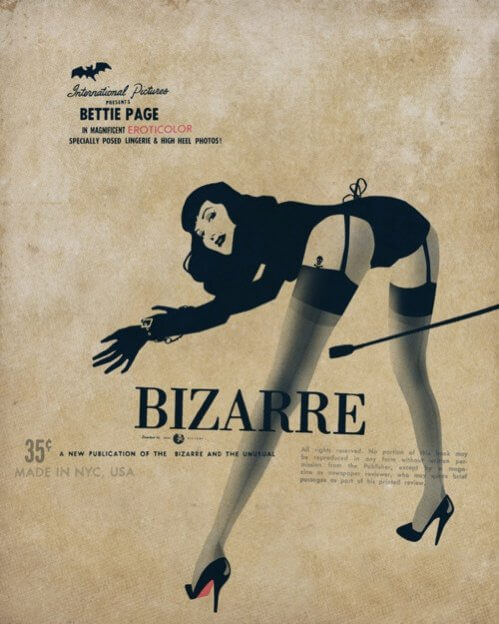Nonsense: The negative perception of BDSM in the bedroom Don’t let the acronym intimidate you. BDSM, widely stigmatized in films, books, media, and pornography, often portrayed as abusive and inflicted...
Nonsense: The negative perception of BDSM in the bedroom
Don’t let the acronym intimidate you. BDSM, widely stigmatized in films, books, media, and pornography, often portrayed as abusive and inflicted on unwilling participants, is not the sort of kinky practice that violently endangers individuals when practiced within a caring relationship and attentively enjoyed. The acronym BDSM stands for bondage, discipline, sadism and masochism. These terms definitely raise the eyebrows of many, however, in practice, these terms are often very different than how they are perceived. The practice of tying up a partner in any way is an act of bondage; the act of following directions is an act of discipline. Being swatted with a crop (or anything) lightly on the ass (or anywhere else, for that matter) can also be considered an act of sadism and masochism.

In the mainstream media, terms like these are often interpreted in the harshest possible form and, for the uneducated, do not normally elicit images of lightly slapping crops on a moaning woman’s (or man’s) skin, or tying a partner up with silk stockings. The terms for BDSM practices vary and are utilized in different ways. As in the “vanilla” world, every relationship is different: Those practicing BDSM have their own unique desires and relationship styles. One thing is absolutely essential for a couple to have a successful and pleasurable BDSM experience with one another: Absolute mutual consent and desire for the experience.
BDSM terminology: What does BDSM really mean?
An overview of BDSM terminology includes D/s, for dominance and submission, B&D, for bondage and discipline, and S&M for sadomasochism. The small “s” in D/s is usually intended to symbolize the desire of the submissive to submit, allowing themselves to be perceived as “smaller” than their dominant partner. Among safe, sane, and consensual BDSM practitioners, it is widely understood that there is no one “right” way to practice BDSM. While some circles of the BDSM community may practice similar rules and styles, there are plenty of partners who do not get involved in their local BDSM community or dungeon and prefer to keep their practice and relationships private.

Interested in trying BDSM?
It can be a nerve-wracking business for those interested in trying any BDSM practice to introduce it to their partner, for fear of being perceived in a negative way or as a deviant. This is a valid concern considering how BDSM is typically perceived by the public in general. A common suggestion among experienced practitioners is to not approach a partner with terms like the above, but instead to make gradual and comfortable introductions to build on. Communication and openness is also crucial. For example, one interested in experiencing nipple clamps could begin with asking their partner for light pinching with the fingers, and over a series of encounters, request a gradual increase in pressure, all the while being open and attentive to their partners comfort level with the activity. Those interested in trying erotic spanking with their partner should begin with an open, honest, and kind approach, expressing interest and sweetly asking permission in a passionate moment to try a few swats lightly. Warming up the gluteal area with light spanking can be exciting and arousing for both involved. Light play can graduate into more intense practices, like crops, caning, or whips, depending on your curiosity level.

Safe, sane, and consensual BDSM
Whips may sound extreme to some, but there are plenty of practitioners who enjoy the eroticism of receiving sensual and erotic stimulation from the sting of a whip. As with any tool, however, it is absolutely essential to understand how to use it before unleashing gleeful strokes on an eager partner and severely harming them. While there is a danger of physically harming someone, there is equal opportunity for emotional harm. One partner may thoroughly enjoy dirty talk that others may perceive as degrading (terms like whore, slut, etc.). Another partner may strongly desire what is called “aftercare” immediately following a “scene” or experience, and if that tenderness and attentiveness are not provided, there can be emotional ramifications and wounds. The key to understanding what any partner wants or is comfortable within any relationship, BDSM practice or no, all lie within the same word: communication. It is entirely possible to have a passionate, fun, and erotic experience within a relationship, however, if needs, dislikes, and desires are not crisply and clearly expressed before any activities take place of the BDSM nature, it can be like playing a game of relationship roulette.

For further information on how to safely practice BDSM activities, have a look at SM101 by Jay Wiseman, and/or get in touch with your local BDSM community to seek out advice from experienced and trustworthy practitioners. Your local community is usually easily found online and located within your nearest prominent city.








